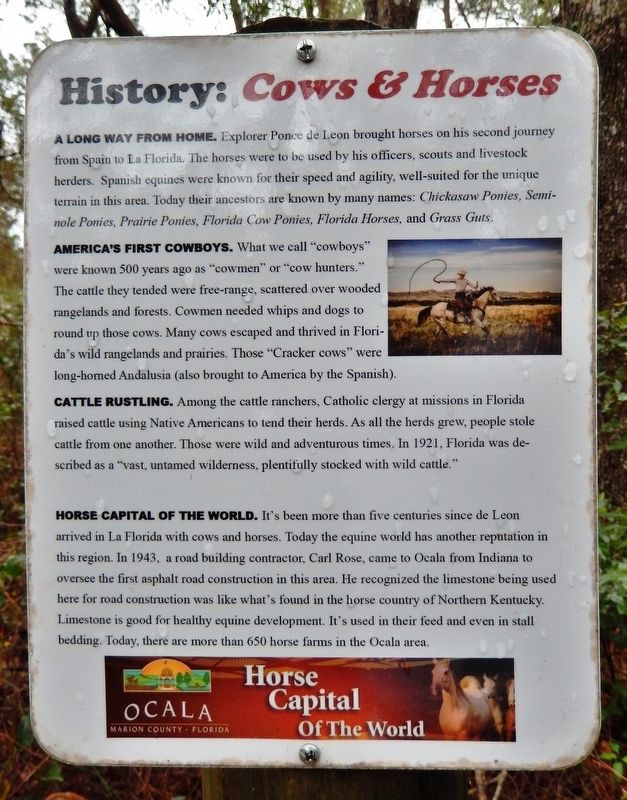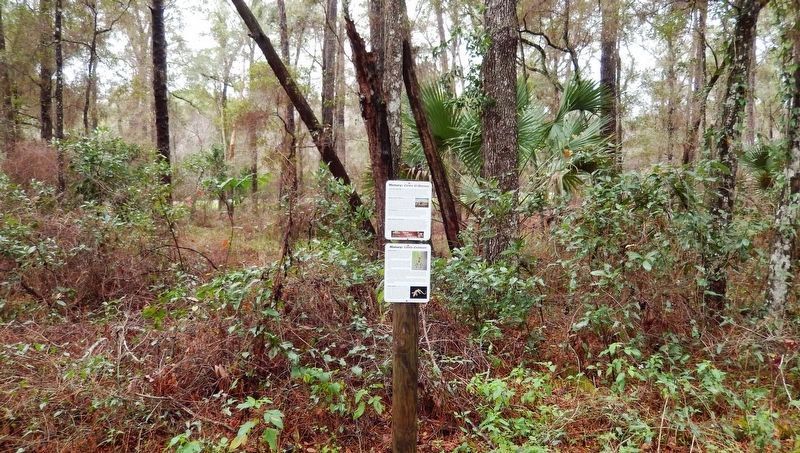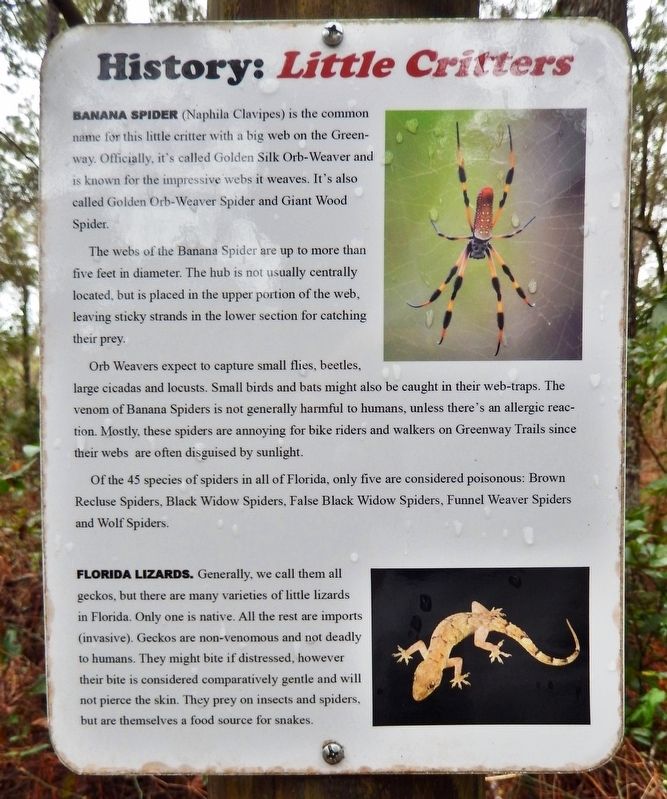Near Ocala in Marion County, Florida — The American South (South Atlantic)
History: Cows & Horses
Historic Florida Barge Canal Trail
America’s First Cowboys. What we call "cowboys" were known 500 years ago as "cowmen" or "cow hunters." The cattle they tended were free-range, scattered over wooded rangelands and forests. Cowmen needed whips and dogs to round up those cows. Many cows escaped and thrived in Florida's wild rangelands and prairies. Those "Cracker cows" were long-horned Andalusia (also brought to America by the Spanish).
Cattle Rustling. Among the cattle ranchers, Catholic clergy at missions in Florida raised cattle using Native Americans to tend their herds. As all the herds grew, people stole cattle from one another. Those were wild and adventurous times. In 1921, Florida was described as a "vast, untamed wilderness, plentifully stocked with wild cattle."
Horse Capital of the World. It's been more than five centuries since de Leon arrived in La Florida with cows and horses. Today the equine world has another reputation in this region. In 1943, a road building contractor, Carl Rose, came to Ocala from Indiana to oversee the first asphalt road construction in this area. He recognized the limestone being used here for road construction was like what's found in the horse country of Northern Kentucky. Limestone is good for healthy equine development. It's used in their feed and even in stall bedding. Today, there are more than 650 horse farms in the Ocala area.
Banana Spider (Naphila Clavipes) is the common name for this little critter with a big web on the Greenway. Officially, it's called Golden Silk Orb-Weaver and is known for the impressive webs it weaves. It's also called Golden Orb-Weaver Spider and Giant Wood Spider.
The webs of the Banana Spider are up to more than five feet in diameter. The hub is not usually centrally located, but is placed in the upper portion of the web, leaving sticky strands in the lower section for catching their prey.
Orb Weavers expect to capture small flies, beetles, large cicadas and locusts. Small birds and bats might also be caught in their web-traps. The venom of Banana Spiders is not generally harmful to humans, unless there's an allergic reaction. Mostly, these spiders are annoying for bike riders and walkers on Greenway Trails since their webs are often disguised by sunlight.
Of
the 45 species of spiders in all of Florida, only five are considered poisonous: Brown Recluse Spiders, Black Widow Spiders, False Black Widow Spiders, Funnel Weaver Spiders and Wolf Spiders.
Florida Lizards. Generally, we call them all geckos, but there are many varieties of little lizards in Florida. Only one is native. All the rest are imports (invasive). Geckos are non-venomous and not deadly to humans. They might bite if distressed, however their bite is considered comparatively gentle and will not pierce the skin. They prey on insects and spiders, but are themselves a food source for snakes.
Erected by Florida State Parks.
Topics. This historical marker is listed in these topic lists: Animals • Exploration • Roads & Vehicles.
Location. 29° 6.055′ N, 82° 5.308′ W. Marker is near Ocala, Florida, in Marion County. Marker can be reached from the intersection of Southeast 80th Street (County Road 328) and South Pine Avenue (U.S. 441), on the right when traveling east. Marker is located along the trail at "The Island" - Cross Florida Barge Canal Interpretive Park, just south of the Marion County Sheriff's Station. Touch for map. Marker is at or near this postal address: 3260 Southeast 80th Street, Ocala FL 34480, United States of America. Touch for directions.
Other nearby markers. At least 8 other markers are within walking distance
of this marker. History: Monkeys & Boars (here, next to this marker); Green Monsters (within shouting distance of this marker); History: Crops (about 300 feet away, measured in a direct line); Greenway Greenlife (about 300 feet away); Cat Face (about 300 feet away); Florida Crackers (about 400 feet away); Florida Seminoles (about 500 feet away); A Tribe Lost: Timicua (about 500 feet away). Touch for a list and map of all markers in Ocala.
Related markers. Click here for a list of markers that are related to this marker. Historic Florida Barge Canal Trail
Also see . . .
1. Florida Cracker Horse (Wikipedia). The Spanish first brought horses to Florida with their expeditions in the early 16th century; as colonial settlement progressed, they used the horses for herding cattle. These horses developed into the Florida Cracker type seen today, and continued to be used by Florida cowboys (known as "crackers") until the 1930s. At this point they were superseded by American Quarter Horses needed to work larger cattle brought to Florida during the Dust Bowl. (Submitted on February 26, 2021, by Cosmos Mariner of Cape Canaveral, Florida.)
2. Rosemere Farm Paved The Way For Ocala’s Thoroughbred Industry. Born on a Draft Horse farm in Indiana, Carl G. Rose found his footing in road construction, and he moved to Florida in 1916 to bring the first asphalt roads to the state. Rose was drawn to Ocala for the limestone and for its cheap land prices. Not only did the calcium-rich limestone in the Ocala soil make sturdy road materials, Rose speculated it would make sturdy Thoroughbreds. (Submitted on February 26, 2021, by Cosmos Mariner of Cape Canaveral, Florida.)
3. What Makes Ocala the Horse Capital of the World?. Carl G. Rose developed the first thoroughbred horse farm in Florida in 1943. Rose bought land along State Road 200 in 1943 to build Rosemere Farm. One of Rose’s horses won at Tropical Park in Miami the following year, becoming the first Florida-raised horse to win. Ocala-bred Affirmed, an American Thoroughbred racehorse, won the Triple Crown in 1978. Today, Marion County has more than 1,200 horse farms, which includes 900 thoroughbred farms on more than 77,000 acres. (Submitted on February 26, 2021, by Cosmos Mariner of Cape Canaveral, Florida.)
4. Fossil Horses. Students often learn in history class that the Spaniards brought horses to the New World in the 1500s, but the fossil record shows horses actually originated in North America at least 55 million years ago and roamed the continent before becoming extinct at the end of the last Ice Age, about 10,000 years ago. (Submitted on February 26, 2021, by Cosmos Mariner of Cape Canaveral, Florida.)
Additional keywords. History: Cows & Horses
Credits. This page was last revised on February 26, 2021. It was originally submitted on February 20, 2021, by Cosmos Mariner of Cape Canaveral, Florida. This page has been viewed 201 times since then and 9 times this year. Photos: 1, 2, 3. submitted on February 26, 2021, by Cosmos Mariner of Cape Canaveral, Florida.


